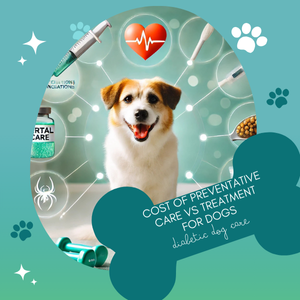Preventative care isn’t just a buzzword in dog ownership—it’s a cornerstone of responsible pet care. This proactive approach includes vaccinations, regular check-ups, keeping their teeth clean, and maintaining a balanced diet with plenty of exercise. These simple steps can make all the difference to your dog’s health.

Additionally, preventative care is cost-effective. Paying for vaccines and regular vet visits might seem like an expense you would rather avoid, but comparing those to the bills you’d face dealing with illnesses like parvovirus or heartworm, the math is in your favor. Prevention is not only better than the cure for your dog, it’s better for your finances too.
Veterinarians back this up wholeheartedly. They’ve seen countless cases where preventative care would have spared the dogs the discomfort of tests and treatment and would have spared their caretakers the emotional and financial stress of treating their sick dogs.
Canine Vaccinations vs Treatment
Vaccinating your dog is a crucial and cost-effective way to protect them from serious diseases. Dog vaccines typically range from $15 to $100. For puppies, a full round of shots, including protection from rabies, distemper, parvo, hepatitis, and parainfluenza (often in a combined DHPP vaccine), will cost about $90 to $120.
Adult dogs need booster shots for rabies and DHPP every 1 to 3 years. If your regular vet seems expensive, consider pet insurance that covers vaccinations, or seek out a low-cost vaccination clinic to help manage costs while keeping your dog protected.
Treatment
Distemper is a highly infectious and potentially fatal illness. In the early stages, dogs have flu-like respiratory and gastrointestinal symptoms. But it also attacks the nervous system and dogs who survive distemper typically have lasting neurological problems. On average, the cost of treating distemper in dogs ranges from $500 to $2,000 or more according to an educational pet website from Petco Animal Supplies Stores.
Hepatitis is a virus that attacks the liver and other organs causing the liver to become inflamed which causes cell death that affects how the liver or other organs function. There is no cure for Hepatitis. Once your dog is infected you will need to manage the illness. The initial exam for the diagnosis will cost around $150. The ongoing costs could range into the thousands depending on the need for more tests and the level of damage done to the organs.
Parvo is a highly contagious, viral disease that affects a dog’s gastrointestinal tract. Puppies are more susceptible, although dogs can get it at any age and it becomes fatal quickly. Parvo is also expensive to treat. The combined cost of diagnosis and treatment can range between $500 and $2000 on average, not including a potential hospital stay or follow-up care and medications.
Parainfluenza can also lead to expensive treatments. A vet visit for canine flu can cost around $600 including the tests to confirm the diagnosis. While the flu is not as deadly as the other three in DHPP, it can lead to complications like pneumonia.
Rabies is an incurable virus that attacks the brain and spinal cord. On average, canine rabies vaccine costs range from $40 to $75 per dose plus annual boosters. The initial vaccination requires three consecutive rounds of shots. The typical price is around $15 to $25 each. Once your dog shows symptoms of rabies there is no treatment or cure. Sadly, if your veterinarian believes your dog has rabies rabies, they may need to be euthanized since they could spread the virus.

Staying up-to-date with vaccinations allows your dog to live a healthy and full life while also allowing you to avoid paying for costly treatments. If regular vet care is too expensive, consider pet insurance that covers preventative care or visit low-cost vaccination clinics to stay proactive about your dog’s health.
Heartworm Pills vs. Treatment
Preventing heartworm is another area where preventative care saves both money and stress. The cost of heartworm pills is relatively low. Tablets cost between $6 and $18 per month. These medications are highly effective and easy to get with a prescription from your veterinarian at one of your regular visits.
Treatment
Treating heartworm is no fun for your dog. There are uncomfortable side effects and long-term restrictions on their activity. Before treatment can even begin, your dog will need a series of diagnostic tests and treatments. The financial cost is significant as well. The initial tests and treatment can cost anywhere from $100 to over $1,000 depending on the severity of the infection at the time of diagnosis and your dog’s size. Then the ongoing treatment typically costs between $500 and $1,500. In some cases, the treatment needs to be repeated.
This makes preventing heartworm with monthly pills the most cost-effective choice and the most humane choice compared to treating a heartworm infection.
Canine Dental Care vs Treatment
A deep dental cleaning for your dog, which includes scaling, polishing, and a thorough exam, typically costs between $170 and $350. While this might seem like an added expense, think of it as an investment. With just one or two cleanings a year, you’re helping prevent serious dental problems down the line.

Treatment
Extractions are often the result when dental problems are left untreated. Not only is this painful for your dog, but it also adds up financially. Simple extractions cost between $50 to $200 per tooth. If your dog needs multiple teeth pulled, you can see how this can quickly become expensive. More complex extractions, such as those involving larger or more delicate teeth, can cost even more.
Compare that to a yearly dental cleaning and the difference is clear: prevention is much easier on your dog and more cost-effective for your bank account.
Regular Vet Visits vs Delaying Treatment for Dogs
Ignoring early signs and delaying treatment can cause something simple to cascade into something dangerous or chronic. Delayed treatment is also a slippery slope from a financial standpoint. What would have been a $50 vet visit could balloon into thousands of dollars if health issues are put off or ignored. Ear infections or dental issues might seem minor initially but they can escalate quickly. Catching something early might cost less than a new pair of sneakers, but delaying could lead to surgery or months or years of medication that would stretch anyone’s budget.
Studies show that dogs with early intervention care have lower lifetime health costs and better overall health scores. Consulting your vet sooner rather than later can dramatically change the outcomes for your dog’s long-term health and your finances.
Balanced Diet and Exercise vs Potential Treatments
Maintaining a balanced diet for your dog is another investment in their long-term health that also helps prevent costly health problems down the line. A diet balanced in proteins, fats, vitamins, and minerals ensures that your dog receives essential nutrients to support their immune system, maintain a healthy weight, and keep organs functioning optimally. Dogs on balanced diets are less likely to suffer from issues like brittle bones, skin disorders, and a weakened immune response—problems that result from missing nutrients in their diet and that often require veterinary treatment and medications. While premium dog foods or home-prepared, balanced meals and supplements may be pricier initially, they provide preventive health benefits that reduce the likelihood of frequent vet visits and treatments, leading to cost savings and a healthier, happier dog.
Balanced diets and daily exercise help prevent obesity, which is a leading cause of chronic conditions in dogs, including diabetes, arthritis, and heart disease. These conditions not only reduce your dog’s quality of life but can also be expensive to treat, with long-term costs for medications, specialized diets, and additional vet visits.

Exercise also supports your dog’s mental health. By committing to regular exercise—whether it’s daily walks, playtime, or agility activities—you invest in your dog’s physical and emotional well-being.
Preventative Care is Worth the Investment
Investing in preventative care for your dog is one of the best decisions you can make for both their health and your finances. Whether it’s a healthy diet, regular vet check-ups, or staying current on vaccinations, small investments in preventative care can make a big difference, saving you from unexpected and expensive veterinary bills, and ensuring your dog enjoys a vibrant, happy life by your side.
Thanks for reading. I’d love to hear from you. What experiences have you had with preventative care? Please leave any questions or comments below.

